
Catacomb of Callixtus
Encyclopedia
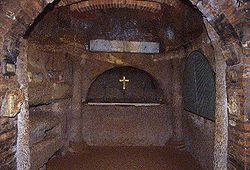
Catacombs of Rome
The Catacombs of Rome are ancient catacombs, underground burial places under or near Rome, Italy, of which there are at least forty, some discovered only in recent decades. Though most famous for Christian burials, either in separate catacombs or mixed together, they began in the 2nd century, much...
on the Appian Way
Appian Way
The Appian Way was one of the earliest and strategically most important Roman roads of the ancient republic. It connected Rome to Brindisi, Apulia, in southeast Italy...
, most notable for containing the Crypt of the Popes (Italian
Italian language
Italian is a Romance language spoken mainly in Europe: Italy, Switzerland, San Marino, Vatican City, by minorities in Malta, Monaco, Croatia, Slovenia, France, Libya, Eritrea, and Somalia, and by immigrant communities in the Americas and Australia...
: Capella dei Papi), which contained the tombs of several popes from the 2nd to 4th centuries. The crypt
Crypt
In architecture, a crypt is a stone chamber or vault beneath the floor of a burial vault possibly containing sarcophagi, coffins or relics....
fell into disuse and decay as the remaining relics were translated from the catacombs to the various churches of Rome
Churches of Rome
There are more than 900 churches in Rome. Most, but not all, of these are Roman Catholic, with some notable Roman Catholic Marian churches.The first churches of Rome originated in places where Christians met. They were divided into three categories:...
; the final wave of translations from the crypt occurred under Pope Sergius II
Pope Sergius II
Pope Sergius II was Pope from January 844 – January 24, 847.On the death of Gregory IV the archdeacon John was proclaimed pope by popular acclamation, while the nobility elected Sergius, a Roman of noble birth. The opposition was suppressed, with Sergius intervening to save John's life...
in the 9th century before the Lombard invasion
Lombards
The Lombards , also referred to as Longobards, were a Germanic tribe of Scandinavian origin, who from 568 to 774 ruled a Kingdom in Italy...
, primarily to San Silvestro in Capite
San Silvestro in Capite
The Church of Saint Sylvester in Capite is a Roman Catholic minor basilica and titular church in Rome dedicated to Pope Saint Sylvester I. Built in the 8th century as a shrine for the relics of the saints and martyrs from the Catacombs, the church is the National church of Great Britain.The Latin...
, which unlike the Catacomb was within the Aurelian Walls
Aurelian Walls
The Aurelian Walls is a line of city walls built between 271 and 275 in Rome, Italy, during the reign of the Roman Emperors Aurelian and Probus....
.
The Catacomb is believed to have been created by future Pope Callixtus I
Pope Callixtus I
Pope Saint Callixtus I or Callistus I was pope from about 217 to about 222, during the reigns of the Roman Emperors Elagabalus and Alexander Severus...
, then a deacon of Rome, under the direction of Pope Zephyrinus
Pope Zephyrinus
Pope Saint Zephyrinus, born in Rome, was bishop of Rome from 199 to 217. His predecessor was bishop Victor I. Upon his death on December 20, 217, he was succeeded by his principal advisor, bishop Callixtus I.-Papacy:...
, enlarging pre-existing early Christian hypogea
Hypogeum
Hypogeum or hypogaeum literally means "underground", from Greek hypo and gaia . It usually refers to an underground, non-Christian temple or a tomb...
. Callixtus himself was entombed in the Catacomb of Calepodius
Catacomb of Calepodius
The Catacomb of Calepodius is one of the Catacombs of Rome, notable for containing the tombs of Pope Callixtus I and Pope Julius I, along with the eponymous Calepodius.Callixtus I was interred in the Catacomb of...
on the Aurelian Way
Aurelian Way
Via Aurelia is an ancient highroad of Italy, the date of the construction of which is unknown. It ran from Rome to Alsium, where it reached the sea, and thence along the...
. The Catacomb and Crypt were rediscovered in 1854 by the pioneering Italian archaeologist Giovanni Battista de Rossi
Giovanni Battista de Rossi
Giovanni Battista de Rossi was an Italian archaeologist, famous outside his field for his rediscovery of early Christian catacombs.-Life and works:He was born in Rome...
.
Papal tombs
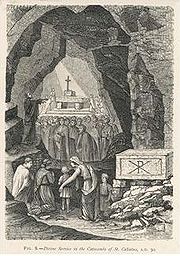
Pope Damasus I
Pope Saint Damasus I was the bishop of Rome from 366 to 384.He was born around 305, probably near the city of Idanha-a-Velha , in what is present-day Portugal, then part of the Western Roman Empire...
built a staircase in the 4th century. Among the discovered Greek language
Greek language
Greek is an independent branch of the Indo-European family of languages. Native to the southern Balkans, it has the longest documented history of any Indo-European language, spanning 34 centuries of written records. Its writing system has been the Greek alphabet for the majority of its history;...
inscriptions are those associated with: Pope Pontian
Pope Pontian
Pope Pontian or Pontianus was Pope from 21 July 230 to 29 September 235.A little more is known of Pontian than his predecessors, apparently from a lost papal chronicle that was available to the compiler of the Liberian Catalogue of bishops of Rome, made in the fourth century.During his pontificate...
, Pope Anterus
Pope Anterus
Pope Saint Anterus was Pope from November 21, 235 to January 3, 236, and succeeded Pope Pontian, who had been deported from Rome along with the antipope Hippolytus to Sardinia....
, Pope Fabian
Pope Fabian
Pope Fabian was Pope from January 10, 236 to January 20, 250, succeeding Pope Anterus.Eusebius of Caesarea relates how the Christians, having assembled in Rome to elect a new bishop, saw a dove alight upon the head of Fabian, a layman and stranger to the city, who was thus marked out for this...
, Pope Lucius I
Pope Lucius I
Pope Saint Lucius I was Pope from June 25, 253 to March 5, 254.St. Lucius was born in Rome at an unknown date; nothing is known about his family except his father's name, Porphyrianus. He was elected probably on June 25, 253, and died on March 5, 254...
, and Pope Eutychian
Pope Eutychian
Pope Saint Eutychian or Eutychianus was pope from January 4, 275 to December 7, 283 ....
. A more lengthy inscription to Pope Sixtus II
Pope Sixtus II
Pope Sixtus II or Pope Saint Sixtus II was Pope from August 30, 257 to August 6, 258. He died as a martyr during the persecution by Emperor Valerian....
by Furius Dionisius Filocalus has also been discovered.
Outside the Crypt of the Popes, the region of Saints Gaius and Eusebius is so named for the facing tombs of Pope Gaius
Pope Caius
Pope Saint Caius or Gaius was Pope from December 17, 283 to April 22, 296. Christian tradition makes him a native of the Dalmatian city of Salona, today Solin near Split, the son of a man also named Caius, and a member of a noble family related to the Emperor Diocletian.Little information on Caius...
("Caius") and Pope Eusebius
Pope Eusebius
Pope Saint Eusebius was pope in the year 309 or 310....
(translated from Sicily). In another region, there is a tomb attributed to Pope Cornelius
Pope Cornelius
Pope Saint Cornelius was pope from his election on 6 or 13 March 251 to his martyrdom in June 253.- Christian persecution :Emperor Decius, who ruled from 249 to 251 AD, persecuted Christians in the Roman Empire rather sporadically and locally, but starting January in the year 250, he ordered all...
, bearing the inscription "CORNELIVS MARTYR", also attributed to Filocalus.
A plaque placed by Pope Sixtus III
Pope Sixtus III
Pope Saint Sixtus III was pope from 31 July 432 to 18 August 440.The name of Sixtus is often connected with a great building boom in Rome: Santa Sabina on the Aventine Hill was dedicated during his pontificate and he built Santa Maria Maggiore, whose dedication to Mary the Mother of God reflected...
(c. 440) lists the following popes: Sixtus II, Dionysius, Cornelius, Felix, Pontianus, Fabianus, Gaius, Eusebius, Melchiades, Stephen, Urban I, Lucius, and Anterus, a list not including any 2nd century tombs. The Crypt of the Popes quickly filled up in the 4th century, causing other popes to be buried in related catacombs, such as the Catacomb of Priscilla
Catacomb of Priscilla
The Catacomb of Priscilla on the Via Salaria in Rome, Italy, is situated in what was a quarry in Roman times. This quarry was used for Christian burials from the late 2nd century through the 4th century. Some of the walls and ceilings display fine decorations illustrating Biblical scenes...
(underneath San Martino ai Monti
San Martino ai Monti
San Martino ai Monti, also known as Santi Silvestro e Martino ai Monti - Titolo Equizio, is a basilica church in Rome, Italy, in the Rione Monti neighbourhood.-History:...
), the Catacomb of Balbina
Balbina
Memorials of St. Balbina are to be found at Rome in three different spots which are connected with the early Christian antiquities of that city. In the purely legendary account of the martyrdom of St. Alexander mention is made of a tribune Quirinus who died a martyr and was buried in the catacomb...
(only Pope Mark
Pope Mark
Pope Saint Mark the apostle or Marcus was Pope from January 18, 336 to October 7, 336, date of his death.Little is known of his early life. According to the Liber Pontificalis, he was a Roman, and his father's name was Priscus...
), the Catacomb of Calepodius
Catacomb of Calepodius
The Catacomb of Calepodius is one of the Catacombs of Rome, notable for containing the tombs of Pope Callixtus I and Pope Julius I, along with the eponymous Calepodius.Callixtus I was interred in the Catacomb of...
(only Pope Callixtus I
Pope Callixtus I
Pope Saint Callixtus I or Callistus I was pope from about 217 to about 222, during the reigns of the Roman Emperors Elagabalus and Alexander Severus...
and Pope Julius I
Pope Julius I
Pope Saint Julius I, was pope from February 6, 337 to April 12, 352.He was a native of Rome and was chosen as successor of Mark after the Roman seat had been vacant for four months. He is chiefly known by the part he took in the Arian controversy...
), the Catacomb of Pontian
Catacomb of Pontian
The Catacomb of Pontian is one of the catacombs of Rome on the Via Portuensis, notable for containing the original tombs of Pope Anastasius I and his son Pope Innocent I...
(only Pope Anastasius I
Pope Anastasius I
Pope Saint Anastasius I, born in Rome the son of Maximus, was pope from November 27, 399 to 401.He condemned the writings of the Alexandrian theologian Origen shortly after their translation into Latin. He fought against these writings throughout his papacy and in 400 he called a council to discuss...
and Pope Innocent I
Pope Innocent I
-Biography:He was, according to his biographer in the Liber Pontificalis, the son of a man called Innocens of Albano; but according to his contemporary Jerome, his father was Pope Anastasius I , whom he was called by the unanimous voice of the clergy and laity to succeed -Biography:He was,...
, father and son), and the Catacomb of Felicitas (only Pope Boniface I
Pope Boniface I
Pope Saint Boniface I was pope from December 28, 418 to September 4, 422. He was a contemporary of Saint Augustine of Hippo, who dedicated to him some of his works....
).
2nd century
| Pontificate | Portrait | Common English name | Pre-Callixtus translations | Location within Callixtus | Post-Callixtus translations | Notes |
|---|---|---|---|---|---|---|
| 155–166 | 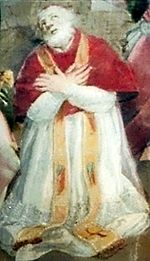 |
Anicetus Pope Anicetus Pope Saint Anicetus was Pope of the Catholic Church from about 150 to about 167 . His name is Greek for unconquered... Saint Anicetus |
Vatican Hill Vatican Hill Vatican Hill is the name given, long before the founding of Christianity, to one of the hills on the side of the Tiber opposite the traditional seven hills of Rome... (some sources say he was originally buried in the Catacomb of Callixtus) |
Unknown | Altemps Palace (Piazza Navona Piazza Navona Piazza Navona is a city square in Rome, Italy. It is built on the site of the Stadium of Domitian, built in 1st century AD, and follows the form of the open space of the stadium. The ancient Romans came there to watch the agones , and hence it was known as 'Circus Agonalis'... ) |
Sarcophagus which may have once contained remains is extant in the Altemps Palace |
| c.166–174/175 |  |
Soter Pope Soter Pope Saint Soter was the Bishop of Rome during the latter half of the 2nd Century with his pontificate, according to the Annuario Pontificio, beginning between 162 and 168 then ending between 170 and 177. Although his name is derived from the Greek word "σωτήρ" , meaning a "saviour" or... Saint Soter |
None | Unknown | San Silvestro in Capite San Silvestro in Capite The Church of Saint Sylvester in Capite is a Roman Catholic minor basilica and titular church in Rome dedicated to Pope Saint Sylvester I. Built in the 8th century as a shrine for the relics of the saints and martyrs from the Catacombs, the church is the National church of Great Britain.The Latin... San Sisto Vecchio San Sisto Vecchio San Sisto Vecchio is a church in Rome, devoted to St. Pope Sixtus II. It was built in the 4th century, and is recorded as the Titulus Crescentianae, thus relating the church to some Crescentia, possibly a Roman woman who founded the church. According to tradition, the church was established by Pope... Toledo Toledo, Spain Toledo's Alcázar became renowned in the 19th and 20th centuries as a military academy. At the outbreak of the Spanish Civil War in 1936 its garrison was famously besieged by Republican forces.-Economy:... , Spain Spain Spain , officially the Kingdom of Spain languages]] under the European Charter for Regional or Minority Languages. In each of these, Spain's official name is as follows:;;;;;;), is a country and member state of the European Union located in southwestern Europe on the Iberian Peninsula... San Martino ai Monti San Martino ai Monti San Martino ai Monti, also known as Santi Silvestro e Martino ai Monti - Titolo Equizio, is a basilica church in Rome, Italy, in the Rione Monti neighbourhood.-History:... |
Possibly never buried in Catacomb of Callixtus and confused with a martyr buried in 304 |
| 199–217 | 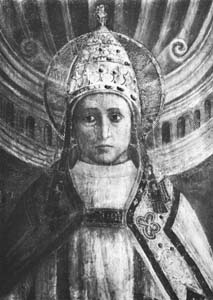 |
Zephyrinus Pope Zephyrinus Pope Saint Zephyrinus, born in Rome, was bishop of Rome from 199 to 217. His predecessor was bishop Victor I. Upon his death on December 20, 217, he was succeeded by his principal advisor, bishop Callixtus I.-Papacy:... Saint Zephyrin |
Private cemetery ("in cymiterio suo") | Not in the Crypt of the Popes | San Silvestro in Capite San Silvestro in Capite The Church of Saint Sylvester in Capite is a Roman Catholic minor basilica and titular church in Rome dedicated to Pope Saint Sylvester I. Built in the 8th century as a shrine for the relics of the saints and martyrs from the Catacombs, the church is the National church of Great Britain.The Latin... |
First pope buried in the Catacomb, which he ordered Callixtus to organize |
3rd century
| Pontificate | Portrait | Common English name | Pre-Callixtus translations | Location within Callixtus | Post-Callixtus translations | Notes |
|---|---|---|---|---|---|---|
| 222/223–230 | 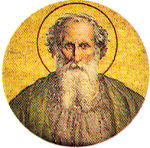 |
Urban I Pope Urban I Pope Saint Urban I was Pope from 14 October 222 to 230. He was born in Rome, Roman Empire and succeeded St. Callixtus I who had been martyred. For centuries it was believed that Urban too was martyred... Saint Urban |
None | Unknown (see notes) | None known | Not to be confused with a non-Roman bishop Urban buried in the catacomb of Praetextatus; slab in Crypt of the Popes bears the Greek words: OYPBANOC E[pivskopoV] ("Urban, Bishop"), but identification is not certain |
| 21 July 230 - 28 September 235 |  |
Pontian Pope Pontian Pope Pontian or Pontianus was Pope from 21 July 230 to 29 September 235.A little more is known of Pontian than his predecessors, apparently from a lost papal chronicle that was available to the compiler of the Liberian Catalogue of bishops of Rome, made in the fourth century.During his pontificate... Saint Pontian |
Sardinia Sardinia Sardinia is the second-largest island in the Mediterranean Sea . It is an autonomous region of Italy, and the nearest land masses are the French island of Corsica, the Italian Peninsula, Sicily, Tunisia and the Spanish Balearic Islands.The name Sardinia is from the pre-Roman noun *sard[],... |
Crypt of the Popes | None known | Translated from Sardinia (the "Isle of Death") by Pope Fabian in 237, buried in the papal crypt on November 12; two extant engravings: IIONTIANOC EIII M[αρτυ]ρ ("Pontianus Bi[shop] M[arty]r") and ENθEΩN [αγιωv 'Eπισχοπωv] IIONTIANE ZHCHC ("Mayest thou live, Pontianus, in God with all") |
| 21 November 235 - 3 January 236 | 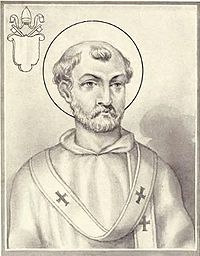 |
Anterus Pope Anterus Pope Saint Anterus was Pope from November 21, 235 to January 3, 236, and succeeded Pope Pontian, who had been deported from Rome along with the antipope Hippolytus to Sardinia.... Saint Anterus |
None | Crypt of the Popes | San Silvestro in Capite San Silvestro in Capite The Church of Saint Sylvester in Capite is a Roman Catholic minor basilica and titular church in Rome dedicated to Pope Saint Sylvester I. Built in the 8th century as a shrine for the relics of the saints and martyrs from the Catacombs, the church is the National church of Great Britain.The Latin... |
Possibly the first pope in the Crypt of the Popes; inscription reads ANΘEPΩC EIII ("Anterus, Bishop") and is broken such that it could have once mentioned him as a martyr |
| 10 January 236 - 20 January 250 |  |
Fabian Pope Fabian Pope Fabian was Pope from January 10, 236 to January 20, 250, succeeding Pope Anterus.Eusebius of Caesarea relates how the Christians, having assembled in Rome to elect a new bishop, saw a dove alight upon the head of Fabian, a layman and stranger to the city, who was thus marked out for this... Saint Fabian |
None | Crypt of the Popes | San Martino ai Monti San Martino ai Monti San Martino ai Monti, also known as Santi Silvestro e Martino ai Monti - Titolo Equizio, is a basilica church in Rome, Italy, in the Rione Monti neighbourhood.-History:... Old St. Peter's Basilica San Sebastiano fuori le mura San Sebastiano fuori le mura San Sebastiano fuori le mura , or San Sebastiano ad Catacumbas , is a basilica in Rome, central Italy... |
Greek inscription from the Catacomb of Callixtus is extant; translated to San Martino by Sergius II (Liber Pontificalis) or combined with Sixtus II in Old St. Peter's (Petrus Mallius); sarcophagus inscribed with ΦABIANOC EIII MP ("Phabianos Bi[shop] M[arty]r") in San Sebastiano fuori le mura |
| 25 June 253 - 5 March 254 | 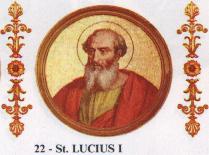 |
Lucius I Pope Lucius I Pope Saint Lucius I was Pope from June 25, 253 to March 5, 254.St. Lucius was born in Rome at an unknown date; nothing is known about his family except his father's name, Porphyrianus. He was elected probably on June 25, 253, and died on March 5, 254... Saint Lucius |
None | Crypt of the Popes | Santa Cecilia in Trastevere Santa Cecilia in Trastevere Santa Cecilia in Trastevere is a 5th century church in Rome, Italy, devoted to Saint Cecilia, in the Trastevere rione.-History:The first church on this site was founded probably in the 3rd century, by Pope Urban I; it was devoted to the Roman martyr Cecilia, martyred it is said under Marcus... San Silvestro in Capite San Silvestro in Capite The Church of Saint Sylvester in Capite is a Roman Catholic minor basilica and titular church in Rome dedicated to Pope Saint Sylvester I. Built in the 8th century as a shrine for the relics of the saints and martyrs from the Catacombs, the church is the National church of Great Britain.The Latin... Santa Prassede Santa Prassede The Basilica of Saint Praxedes , commonly known in Italian as Santa Prassede, is an ancient titular church and minor basilica in Rome, Italy, located near the papal basilica of Saint Mary Major... |
Extant inscription reads "Lucius, Bishop" (Greek: ΛOYKIC) sarcophagus that once held remains is extant in Santa Cecilia in Trastevere |
| 30/31 August 257 - 6 August 258 | 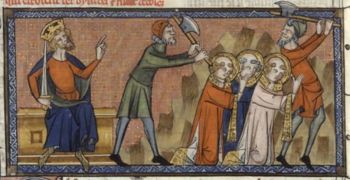 |
Sixtus II Pope Sixtus II Pope Sixtus II or Pope Saint Sixtus II was Pope from August 30, 257 to August 6, 258. He died as a martyr during the persecution by Emperor Valerian.... Saint Sixtus II |
None | Crypt of the Popes | Old St. Peter's Basilica San Sisto Vecchio San Sisto Vecchio San Sisto Vecchio is a church in Rome, devoted to St. Pope Sixtus II. It was built in the 4th century, and is recorded as the Titulus Crescentianae, thus relating the church to some Crescentia, possibly a Roman woman who founded the church. According to tradition, the church was established by Pope... |
Translated from the Catacomb of Callixtus to Old Saint Peter's by Paschal I; translated from Old Saint Peter's to San Sisto Vecchio by Leo IV; lengthy epitaph discovered in the Catacomb of Callixtus |
| 22 July 259 - 26 December 268 |  |
Dionysius Saint Dionysius |
None | Crypt of the Popes | San Silvestre in Capite | Alleged relics of Popes Sylvester I, Stephen I, and Dionysius were exhumed and enshrined beneath the high altar of San Silvestro in Capite in 1601; no archaeological evidence in the Catacomb of Callixtus |
| 5 January 269 - 30 December 274 | 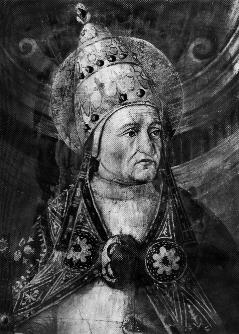 |
Felix I Pope Felix I -Life and works:A Roman by birth, Felix was chosen as Pope on 5 January 269, in succession to Pope Dionysius, who had died on 26 December 268Felix was the author of an important dogmatic letter on the unity of Christ's Person... Saint Felix |
None | Crypt of the Popes | None known | According to legend buried in the "Cemetery of the Two Felixes", which as never been located |
| 4 January 275 - 7 December 283 | 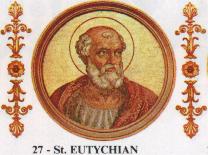 |
Eutychian Pope Eutychian Pope Saint Eutychian or Eutychianus was pope from January 4, 275 to December 7, 283 .... Saint Eutychian |
None | Crypt of the Popes | Abbey of Luni (Sarzana) Sarzana Cathedral Sarzana Cathedral Sarzana Cathedral in Sarzana, Liguria, Italy, is a co-cathedral of the Diocese of La Spezia-Sarzana-Brugnato. It is dedicated to the Assumption of the Virgin Mary... |
Last pope buried in the Crypt of the Popes; inscription reads: EYTYXIANOC EIIC ("Eutychian, Bishop") |
| 17 December 283 - 22 April 296 | 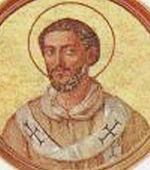 |
Caius Pope Caius Pope Saint Caius or Gaius was Pope from December 17, 283 to April 22, 296. Christian tradition makes him a native of the Dalmatian city of Salona, today Solin near Split, the son of a man also named Caius, and a member of a noble family related to the Emperor Diocletian.Little information on Caius... Saint Caius |
None | Crypt of St. Eusebius | San Silvestro in Capite San Silvestro in Capite The Church of Saint Sylvester in Capite is a Roman Catholic minor basilica and titular church in Rome dedicated to Pope Saint Sylvester I. Built in the 8th century as a shrine for the relics of the saints and martyrs from the Catacombs, the church is the National church of Great Britain.The Latin... Church built over his original house Sant'Andrea della Valle Sant'Andrea della Valle Sant'Andrea della Valle is a basilica church in Rome, Italy, in the rione of Sant'Eustachio. The basilica is the general seat for the religious order of the Theatines.-Overview:... (Barberini chapel) |
Inscription reads: I [AIO]Y EIII[CKOIIOY] / KAΘ / [IIPO I] KAΛ MAIΩ[N] ("The deposition of Caius, Bishop, the 22nd day of April") |
4th Century
| Pontificate | Portrait | Common English name | Pre-Callixtus translations | Location within Callixtus | Post-Callixtus translations | Notes |
|---|---|---|---|---|---|---|
| c.309 - c.310 | 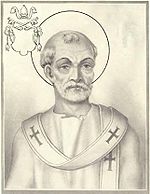 |
Eusebius Pope Eusebius Pope Saint Eusebius was pope in the year 309 or 310.... Saint Eusebius |
Sicily Sicily Sicily is a region of Italy, and is the largest island in the Mediterranean Sea. Along with the surrounding minor islands, it constitutes an autonomous region of Italy, the Regione Autonoma Siciliana Sicily has a rich and unique culture, especially with regard to the arts, music, literature,... |
Crypt of St. Eusebius | None known | Inscription and lengthy epitaph extant |
| 2 July 311 - 11 January 314 | 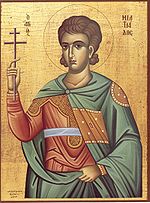 |
Miltiades Pope Miltiades Pope Saint Miltiades, also called Melchiades , was pope from 2 July 311 to 10 January 314.- Origins :He appears to have been a Berber African by birth, but of his personal history nothing is known.- Pontificate :... Melchiades Saint Miltiades |
None | Unknown | San Silvestre in Capite | Only pope entombed in the Catacomb of Callixtus during the "long peace"; buried in a large sarcophagus with a roof-shaped cover |
| 1 October 366 - 11 December 384 |  |
Damasus I Pope Damasus I Pope Saint Damasus I was the bishop of Rome from 366 to 384.He was born around 305, probably near the city of Idanha-a-Velha , in what is present-day Portugal, then part of the Western Roman Empire... Saint Damasus |
None | Unknown | Old St. Peter's Basilica San Lorenzo in Damaso San Lorenzo in Damaso San Lorenzo in Damaso is a basilica church in Rome, Italy, one of several dedicated to the Roman deacon and martyr Saint Lawrence... |
Buried with his mother, Laurentia, and sister, Irene; sarcophagus inscription extant; head allegedly in a reliquary donated by Clement VIII to St. Peter's |

